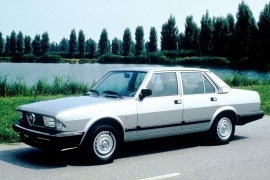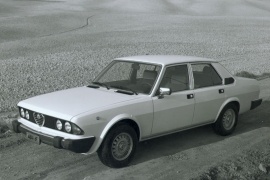ALFA ROMEO 6 Models/Series Timeline, Specifications & Photos
First production year: 1979
Engines: Gasoline
After four years on the market, the Alfa Romeo 6 received a well-deserved facelift adding a new styling and new powerplants for the Italian brand's flagship.
Alfa Romeo was still on high tides in those times, and its name was often placed next to the Premium German carmakers. While it lacked in some areas, it gained in the driving experience. Still, the 6 needed a push to keep up with its main competitors, and that was exactly what Alfa Romeo did in 1983.
Sporting a new front fascia with two rectangular headlights instead of the four-round ones, the 6 showed a modernized look. Moreover, it sported a new plastic bumper that was extended on the lower side, like a spoiler. Even though it was black and unpainted, it was still more attractive than the chromed one used before. It also matched the color of the rubber strips mounted on the door panels and the front fenders. One area where the carmaker bragged about was the zinc-plated bodywork, which was supposed to solve the rust issue faced by the carmaker.
On the inside, Alfa Romeo looked like it had lost its steam and didn't improve the cabin too much. It featured the same rectangular design for the dashboard and the cluttered instrument cluster. There were just too many dials and gauges for ordinary people. On the center stack, at the bottom, under a lid, the carmaker installed a tape player. Unusually though, the buttons for the power windows were placed between the front seats, while the cigarette lighter was on the passenger side area.
Under the hood, Alfa Romeo installed a new fuel-injected powerplant that provided 158 hp (160 PS) from the same 2.0-liter V6 unit. In addition, the Italian carmaker offered a fuel-efficient turbo-diesel engine.
Alfa Romeo introduced in 1976 the Alfa 6 lineup as its new flagship model, a car aimed at executives, a vehicle that was meant to be moved exclusively by six-cylinder engines, hence the name.
The Italian premium brand tried to compete against the best in business in the European market and tried to impress customers with the Alfa 6. It was a car designed by the Centro Stille Alfa, and the development of the new model began in the late ‘60s. Unfortunately, the oil crisis delayed the car’s appearance, and the Italian automaker could finally unveil it in 1979. That delay was just part of why the car suffered from poor sales, which led to the car’s dismissal from the assembly lines in 1986.
With a design that resembled the Alfa Romeo Alfetta but larger, the Alfa 6 featured a four-headlight front fascia with corner-mounted blinkers. Underneath them, the automaker installed a metallic bumper with rubber elements to comply with European standards. The automaker refreshed the car in 1983 and replaced the round headlights with rectangular ones, which was the main visual difference for the upgraded Alfa 6 lineup.
From its profile, the four-door executive sedan showed a clean look with wedged shapes and a crease that ran along the bodywork from nose to tail, crossing over the doors. Since chromed elements were considered a detail of upscale vehicles, the automaker added such finishes for the door mirror caps and flush door handles. Out back, the automaker installed broad taillights that flanked the recessed area for the license plate mounting place, and underneath them was the metallic and rubber bumper wrapped around the car’s rear end.
Inside, the Alfa 6 offered customers an elegant cabin with velour-covered bucket seats at the front and a bench seat for two in the back. In front of the driver, the automaker installed a squared instrument cluster filled with large dials for the speedometer and tachometer, three additional gauges, an analog clock, and several warning lights. The center console housed the buttons for the power windows and gear stick. In the back, the car offered enough room for two adults, but the tall transmission tunnel that crossed the vehicle from front to back limited legroom for a third, middle-seated occupant on the bench seat.
Under the hood, the Alfa 6 featured the latest creation of the Busso V6 engine. It was designed by the brilliant Italian engineer Giuseppe Busso. Unfortunately, Alfa Romeo’s decision to install a 2.5-liter version of this powerplant under the Alfa 6’s hood led to poor car sales in Italy, where the engines with over two-liter displacement suffered from heavy taxation. Power went to the rear wheels via a five-speed manual gearbox or a three-speed automatic via a standard limited-slip differential.

